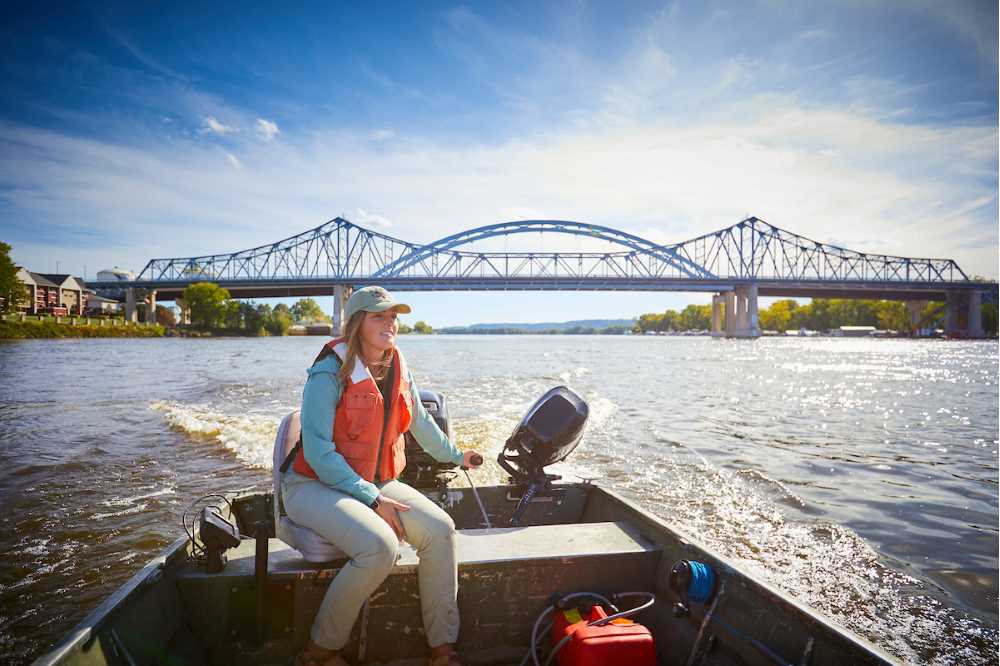Posted 9:46 a.m. Wednesday, Oct. 2, 2019

UWL graduate student, DNR specialist takes a close look at what’s floating in waters close to home.
UWL graduate student, DNR specialist takes a close look at what’s floating in waters close to home
Microplastics — plastic particles in the environment that often require a microscope to see — have emerged as a known pollutant of the world’s water. But how do they impact the Upper Mississippi River?
UWL graduate student Courtney Baker is taking a closer look. Baker began studying microplastics in summer 2018 as an undergraduate environmental biology student at UWL, and she is now continuing as she pursues a master’s degree in aquatic biology. Microplastics, she says, can be ingested by fish and birds, and the chemicals associated with them can disrupt processes within their bodies. They can also work their way into the tissues of fish, which are then consumed by humans.
“I chose to study this because plastic pollution in the waterways is of great concern to the general public, but plastics of such a small size are a relatively new topic,” she says. “I wanted to shed some light on how this size range of plastics behaves in the Mississippi River so that we could start to think of ways to combat this problem.”
Her undergraduate research on microplastics, which she presented at several conferences throughout the state, showed that microplastics are present in the Upper Mississippi River. However, they were not the small microbeads she expected to find. Instead, her studies found plastic fibers such as those that come from clothing. When clothes are washed, the wastewater from the washing machine enters the wastewater treatment plant and then effluent is released into the Mississippi River. A potential solution would be working to test different ways to remove microplastics during the wastewater treatment process. However, she adds, educating the public about a variety of pollutants in wastewater, including nitrates and phosphates, as well as microplastics, is a key starting point.
"The hardest part is getting people to care. Because microplastics cannot be seen without the aid of a microscope, it can be difficult to get the general public to be concerned,” she says. “By raising awareness of this problem, we can start the discussion about how best to remedy this.”
Baker, who landed a position with the Wisconsin Department of Natural Resources as a water resources management specialist after her May 2019 graduation, says her study also draws attention to the idea that pollution in waterways is not reserved to bigger cities. It is found right here in the Mississippi River, which is the home of fish and migratory birds, as well as a vital habitat for different floodplain plants and trees.
“Because of how important the river is in maintaining the balance between us and nature, I believe that it is our job to protect it and try to preserve the river in its most natural form,” she says. “By investigating different types of pollution that affect the river, we can help maintain a healthy ecosystem for generations to come.”
Baker’s work with the DNR is also related to the Mississippi River. Her position is part of the Long Term Resource Monitoring Program, which is a joint effort between multiple government agencies across several states to monitor the overall health of the river.
“I think that my coursework at UWL helped make me a strong candidate for my current job,” she says. “My main career interests lie in field-based jobs, so being able to take classes that included fieldwork and hands-on learning gave me a lot of the outdoor skills that I needed to be qualified for the jobs I’m interested in.”
Next steps? While her undergraduate research focused on the differences in microplastic concentrations relative to the location of the wastewater treatment plant, her graduate research will explore how concentrations differ between backwater locations and main channel locations on the Mississippi River, as well as whether microplastics are settling into the river bottom.
